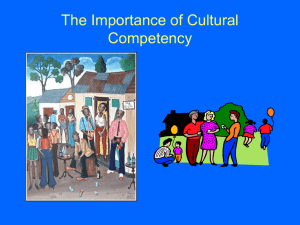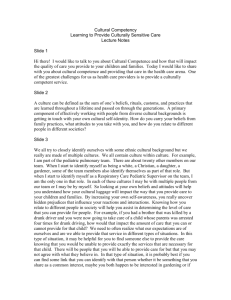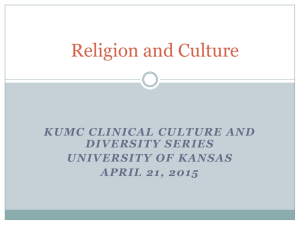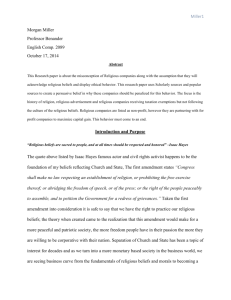cultural sensitivity
advertisement
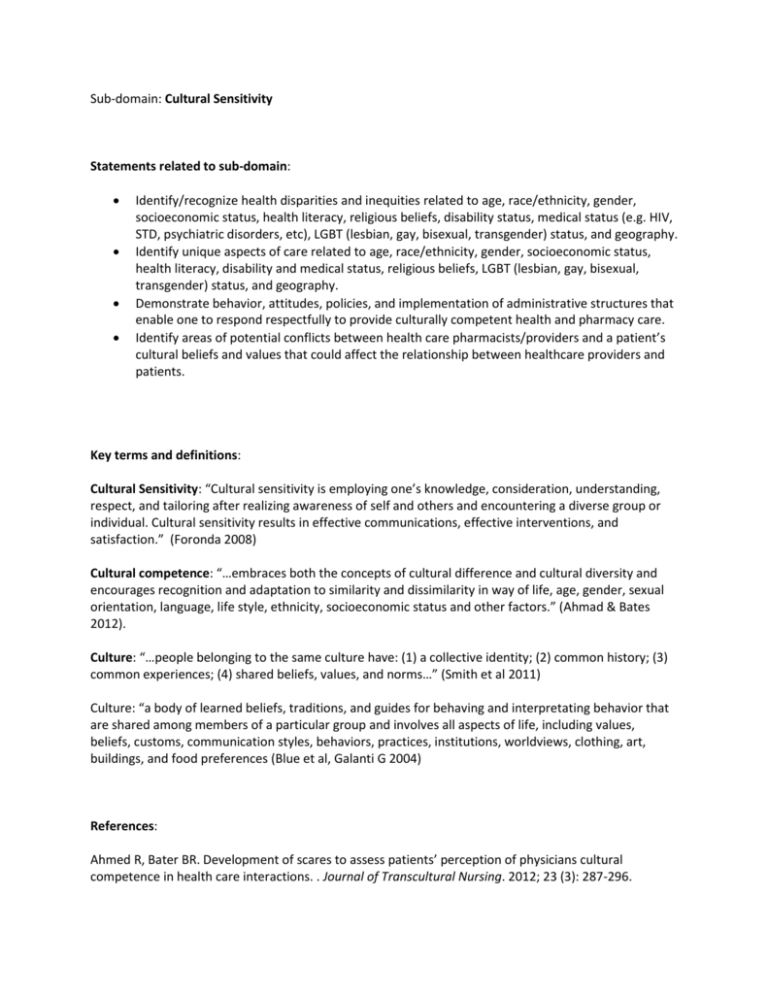
Sub-domain: Cultural Sensitivity Statements related to sub-domain: Identify/recognize health disparities and inequities related to age, race/ethnicity, gender, socioeconomic status, health literacy, religious beliefs, disability status, medical status (e.g. HIV, STD, psychiatric disorders, etc), LGBT (lesbian, gay, bisexual, transgender) status, and geography. Identify unique aspects of care related to age, race/ethnicity, gender, socioeconomic status, health literacy, disability and medical status, religious beliefs, LGBT (lesbian, gay, bisexual, transgender) status, and geography. Demonstrate behavior, attitudes, policies, and implementation of administrative structures that enable one to respond respectfully to provide culturally competent health and pharmacy care. Identify areas of potential conflicts between health care pharmacists/providers and a patient’s cultural beliefs and values that could affect the relationship between healthcare providers and patients. Key terms and definitions: Cultural Sensitivity: “Cultural sensitivity is employing one’s knowledge, consideration, understanding, respect, and tailoring after realizing awareness of self and others and encountering a diverse group or individual. Cultural sensitivity results in effective communications, effective interventions, and satisfaction.” (Foronda 2008) Cultural competence: “…embraces both the concepts of cultural difference and cultural diversity and encourages recognition and adaptation to similarity and dissimilarity in way of life, age, gender, sexual orientation, language, life style, ethnicity, socioeconomic status and other factors.” (Ahmad & Bates 2012). Culture: “…people belonging to the same culture have: (1) a collective identity; (2) common history; (3) common experiences; (4) shared beliefs, values, and norms…” (Smith et al 2011) Culture: “a body of learned beliefs, traditions, and guides for behaving and interpretating behavior that are shared among members of a particular group and involves all aspects of life, including values, beliefs, customs, communication styles, behaviors, practices, institutions, worldviews, clothing, art, buildings, and food preferences (Blue et al, Galanti G 2004) References: Ahmed R, Bater BR. Development of scares to assess patients’ perception of physicians cultural competence in health care interactions. . Journal of Transcultural Nursing. 2012; 23 (3): 287-296. Foronda CL. A concept analysis of cultural sensitivity. Journal of Transcultural Nursing. 2008; 19(3): 207212. Healthy People 2020. Web resource: www.healthypeople.gov. Accessed November 21, 2012. Smith WT, Roth JJ, Okroro O, Kimberlin C, Odedina FT. Disability in cultural competency pharmacy education. Am J Pharm Ed. 2011; 75(2): article 26. US Department of Health and Human Services Agency for Health Research and Quality. National Healthcare Quality Report. 2012: AHRQ Publication No. 12-0006. Galanti G. Caring for patients from different cultures. 3rd edition Philadelphia. Univer Pennsylvania Press 2004 National Center for Cultural Competence. Georgetown University. http://nccc.georgetown.edu/ Evans E. Instructional Design and assessment. An elective course in cultural competence for healthcare professionals. Am J Pharmaceutical Education 2006;70 (3) Article 55 Blue AV. The provision of culturally competent healthcare. http://academicdepartments.musc.edu/fm_ruralclerkship/curriculum/culture.htm. Accessed December 2012
